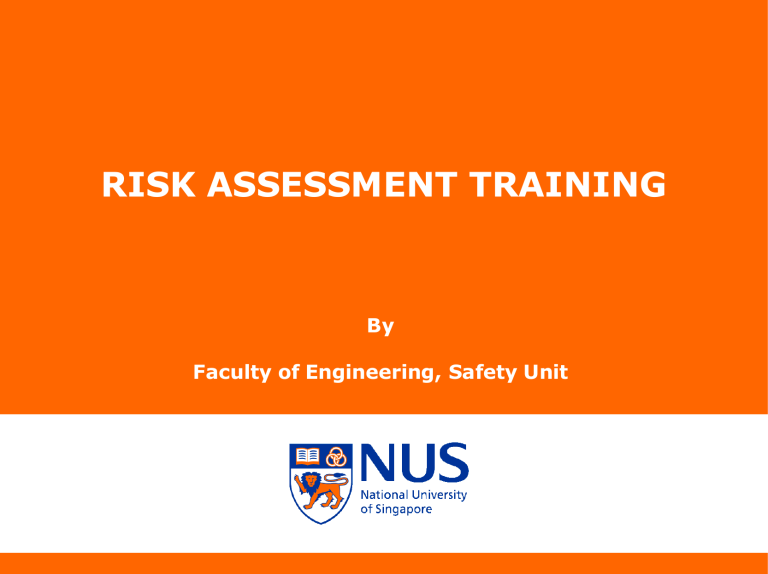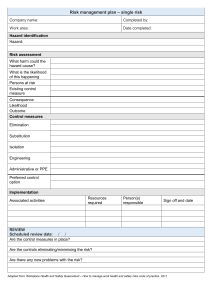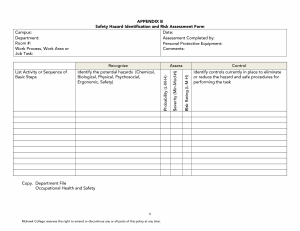
RISK ASSESSMENT TRAINING By Faculty of Engineering, Safety Unit What is Risk Assessment? Risk Assessment is a systematic approach to identify hazards, evaluate risk and incorporate appropriate measures to manage and mitigate risk for any work process or activity. WHY we need to do RA? ➢Protect Ourselves ➢ RA is key to prevention of accident ➢ Everyone deserve to go home safely at the end of the day ➢Elevate safety awareness & ownership ➢ Aware of hazards, risks and controls and practicing safe science ➢University and Faculty Procedures ➢Compliance with Regulations Definition – HAZARD “Source or situation or act with a potential for harm in terms of human injury or ill health or a combination of these” (2 pg13) e.g. - Toxic or flammable substances, electric energy, working at heights etc. Hazard is something that cause harm or injury (MOM Risk Mgt Reg.) Definition - RISK •Combination of the likelihood of an occurrence of a hazardous event or exposure(s) and the severity of injury or ill health that may be caused by the event or exposure(s) (13 page 13) •Likelihood that a hazard will cause a specific harm or injury to person or damage property (MOM) Risk means the chance that someone will be harmed by the hazard. Risk = Hazard effect x Probability (likelihood of Occurrence) Risk Concepts What can go Wrong How likely is it? What are the Impacts Risk Level MANAGE RISK Risk management also includes control and monitoring of risks, as well as communicating these risks Legal Requirement Legal Requirement Workplace Safety & Health Act Effective from 1st March 2006. The WSH Act is an essential part of the new OSH framework to cultivate good safety habits in all individuals at the workplace. It requires every person at the workplace to take “reasonable practicable” steps to ensure the safety and health of every workplace and worker. Legal Requirement Reasonable Practicable Action is considered to be practicable when it is capable of being done. Legal Requirement Reasonable Practicable Reasonable usually takes into account: • The severity of harm & degree of risk (or likelihood) of that injury or harm occurring. Greater risk, reasonable to go to very considerable expense & effort to reduce it • How much is known about the hazard & the ways of eliminating, reducing or controlling it. What are others practicing & what the standards recommend? Legal Requirement Workplace Safety And Health (Risk Management) Regulations 2006 Enforced from 1st September 2006. The WSH (Risk Management) Regulations require employers, the self-employed and principal (including contractor and subcontractor) to conduct risk assessments for the purpose of identifying workplace safety and health risks and implementing measures to control the hazards and reducing the risks. Whoever generates the risk shall manage the risk. Legal Requirement Workplace Safety And Health (Risk Management) Regulations 2006 Penalties Any person who fails to comply may be fined up to $10,000 for the first offence. For a second or subsequent offence, the person may be fined up to $20,000 or jailed up to 6 months or both. R R R R R 3(1) 4(1) 5 6 7 - Conduct Risk Assessment Eliminate, Minimise & Control Risk, Specify Responsibilities Maintain Risk Assessment Record Inform Those At Risk of Risks & Measures, SWP Review of Risk Assessment. RISK MAGEMEMENT REGULATIONS Why is there a need for Risk Management Regulations ? to hold stakeholders accountable for managing the risks they create to reduce risk at source What is a hazard ? means anything with the potential to cause bodily injury What is a risk ? Means the likelihood that a hazard will cause a specific bodily injury to any person. RISK CONTROL What can be done to control risks in the workplace ? Some measures are : ( from most to least preferred ) Elimination – eliminate the hazard from the workplace Substitution - substituting a hazardous substance or process with a less hazardous one. Engineering controls - installing machine guarding or enclosing a noisy machine. Administrative controls - applying a permit-to-work system or lock-out and tag-out procedures. PPE - provision and use of these equipment, AND SWP – Safe Work Procedures RECORDS of RISK ASSESSMENT How often must the risk assessment be reviewed ? • At least once every 3 years; • After an accident; • When there is significant change in work processes, introduction of new machinery or chemicals; • Information on safety technology or requirement made known OFFENCE ESP who contravenes can result in penalty : • for 1st offence –A fine not exceeding $10,000; and • for 2nd or subsequent offence –A fine not exceeding $20,000; and/or –jail term not exceeding 6 months. Risk Assessment Risk Assessment Template Activity or Experiment-Based Risk Assessment Form Department: Name of Experiment/Activity: Location: Name of Person in-charge: Last Review Date: Next Review Date: 1. Hazard Identification SN Task Hazards Possible Consequences Name of PI: 2. Risk Evaluation & Control Existing Risk Control (if any) S L R Additional / New Risk Control Conducted by: (Name, designation) Approved by: (Name, designation) Signature: Signature: Date: Date: S L R Action By Deadline Risk Assessment Process • IDENTIFY the hazards • ASSESS the risks and available control measures • MANAGE the risk – CONTROL the risks through implementation of appropriate control measures – MONITOR the controls to evaluate their effectiveness – Communication of Risks & Controls Risk Assessment Flowchart Identify 1. Selecting Experiments 2. Break Down into Successive Tasks 3. Potential Hazards 4. Potential Harm (Ill health condition) Assess 5. Existing Control Measures 6. Evaluate Risk (Severity, Probability) Manage Risk 7. Hazard Control 8. Additional control measures (Responsible person, timeline) Review, Approval, Communicate Record Keeping and Document Control IDENTIFY POTENTIAL HAZARDS The most important step in any Risk Assessment hazards can only be controlled if they are identified Equipment Procedures People Agents Environment ➢Each step is analyzed for potential inherent hazards ➢Decision on the relevance of any particular hazard come later in the risk assessment processes What are the Hazards in a laboratory? • Chemicals • Slips and trips • Radiation • Falling hazard • Fire • Ergonomics • Electrical • Thermal • Biological • Noise etc… • Physical Acute vs. Chronic Effects IDENTIFY POTENTIAL HARM Identify what are the adverse conditions may arise due the hazard present in your experiments, laboratory or environment ➢ Injury ➢ Identify Source of Harm ➢ First Aid Treatment ➢ Hazardous event or process ➢ Visit Clinic/ hospital ➢ Hazardous substance ➢ Admitted in Hospital ➢ Permanent damage ➢ Equipment ➢ Acute Vs Chronic Effects ➢ Identify who could be harmed ➢ Lab Acquired Infection ➢ Researcher ➢ Property Damage ➢ Breakage of glassware ➢ Others students ➢ Equipment ➢ Contractor/supplier ➢ Furniture ➢ Visitor ➢ Building ➢ Identify how harm could occur ➢ Environmental Release ➢ Release to Air ➢ Accidental fall from height ➢ Water ➢ Contact with corrosive chemicals ➢ Waste materials - solid Risk Evaluation ➢ Consider existing controls ➢ Engineering controls (Fumehood, glovebox, chains for cylinder, others) ➢ Administrative controls (Signage, training, SOPs, others) ➢ Personal Protective Equipment ➢ Existing control will not change the severity but only likelihood ➢ Severity & likelihood is based on 3 by 3 matrix and the respective criteria specified ➢ Risk rating is the product of severity by likelihood ➢ Refer to acceptability criteria on the recommended action for different risk rating ➢ For medium & high risk, additional controls will be required Risk Evaluation Severity Categories & Description Level Human (Impact to Physical Being) Biological Impact Environmental Damage Property Damage (S$) (1) Minor No Injury or light injury requiring only first aid treatment (MC < 4 days MC) May not cause human disease, if does, the disease is unlikely to spread to the community and there is usually effective prophylaxis or treatment available; Reversible Up to $5,000 (2) Moderate Any injury/ill health leading to ≥ 4 days MC or ≥ 1 day hospitalisation or leads to temporary disability Can cause severe human disease, not ordinarily spread by casual contact from one individual to another; it may spread to the community, but there is usually effective prophylaxis or treatment available Reversible but takes years $5,001 to $50,000 (3) Major Fatality, permanent Disability or life threatening disease Can cause lethal human disease, may be readily transmitted from one individual to another, or from animal to human or vice-versa directly or indirectly, or casual contact, it may spread to the community; usually no effective prophylaxis or treatment available Irreversible More than $50,000 Risk Evaluation Likelihood Categories & Description Level Events Frequency (1) Remote Undesired event which may occur but unlikely, once in 5 years (2) Possible Undesired event which is probable, once in a year (3) Frequent Undesired event which probably occur in most circumstances, once or more in a month Risk Evaluation Risk matrix to determine Risk Level Likelihood Remote (1) Occasional (2) Frequent (3) Minor (1) 1 2 3 Moderate (2) 2 4 6 Major (3) 3 6 9 Severity Risk Evaluation Acceptability of Risk Risk Score Risk Level <3 Low Risk 3–4 >4 Medium Risk High Risk Acceptability of Risk Recommended Actions Acceptable No additional risk control measures required. To continue to monitor to ensure risk do not escalate to higher level. Moderately Acceptable Acceptable to carry out the work activity; however, task need to be reviewed to bring risk level to As Low As Reasonably Practicable. Interim control measures such as administrative controls can be implemented. Supervisory oversight required. Not Acceptable Job must not be carried out until risk level is brought to at least medium risk level. Risk controls should not be overly dependant on personal protective equipment. Controls measures should focus on Elimination, substitution and engineering controls. Immediate Management intervention required to ensure risk being brought down to at least medium level before work can be commenced. Control Measures Risk Control ➢ Using Hierarchy of Controls to reduce the risk ➢ Using the concept of As Low As Reasonably Practicable (ALARP) Hierarchy of Risk Control Measures Additional Controls Responsible person and timeline ➢ Additional control for risk rated more than 3 or medium & high risk ➢Reduce risk to as low as reasonably practicable ➢ Who and When? ➢Responsible person to implement the identified control measures and ➢Timeline for completion → update the risk assessment upon completion of the additional control measures Record Keeping 1. Risk Assessment record has to be kept for at least 3 years under the WHS (RM) Regulations requirement. • Recommended to keep record as long as the process/activity is still valid, before end of any product life cycle or to tie in with the period other legislation requires pertaining to the particular process/activity. Implementation & Review 1. Management staff or Principle Investigator will need to approve the implementation of control measures. 2. Monitoring of the process or activity has to be carried to ensure that there is no residual risk or additional risk arising from the control measures. 3. Risk assessors have to check or monitor the new implementation of control measures and to communicate with respective lab or operational personnel. 4. Review on Risk Assessment to be carried on the following basis: - At lease once every three years base on legislative requirements - After an accident/incident occurrence - Any change in process or activity Thank you





